The Star Discovery P150i Wi-Fi comes in two boxes and is straightforward to assemble, allowing you to be up and running in 10 to 15 minutes.
The tube assembly is in one box while the tripod, single-arm mount, spreader tray and a box with the eyepieces, finder and bubble level is in the second.
It’s best to assemble the mount onto the tripod first and then to attach the telescope, before completing it with the red dot finder.
The mount is powered either by eight AA batteries installed in the side of the mount, or via a 12V power tank plugged into the power port.
This telescope features in our list of the best telescopes for beginners
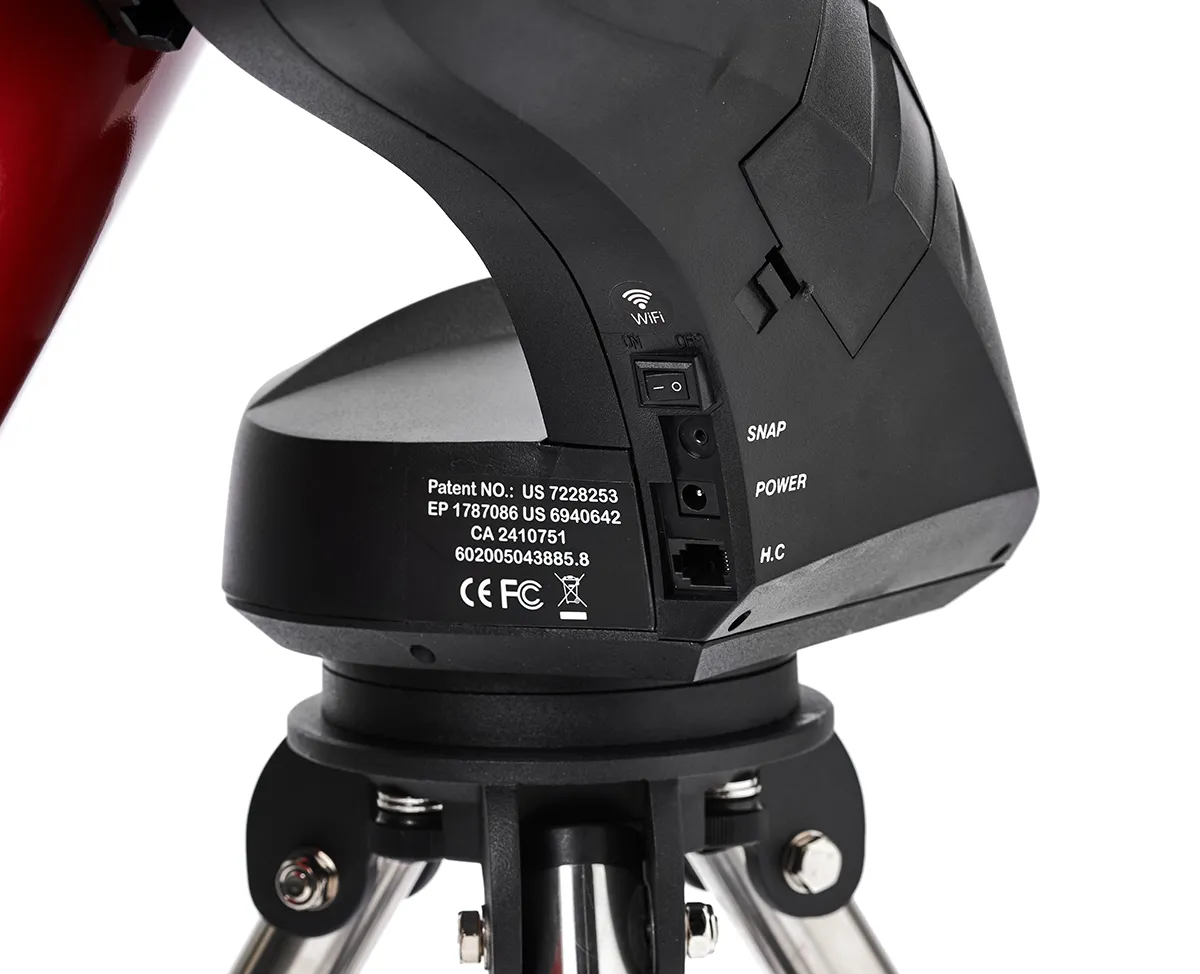
We used the system for several hours with batteries on three occasions and had no trouble, proving this is an easy system to set up, which can be taken anywhere.
The red dot finder is a zero-magnification, no-nonsense piece of kit that can be used during the alignment process, but once it is aligned with the main telescope you’ll find it’s hardly needed at all.
Two eyepieces are supplied, of 25mm and 10mm focal length – the usual combination at this price level.
As the 6-inch primary mirror is a 150mm-diameter parabola and the scope’s focal length is 750mm, the 25mm eyepiece gives a magnification of 30x, while the 10mm gives a magnification of 75x.
These are good choices for this system, giving nice views of deep-sky targets and the Moon. If you add a 2x Barlow lens (not supplied) you can get reasonable views of the brighter planets as well.
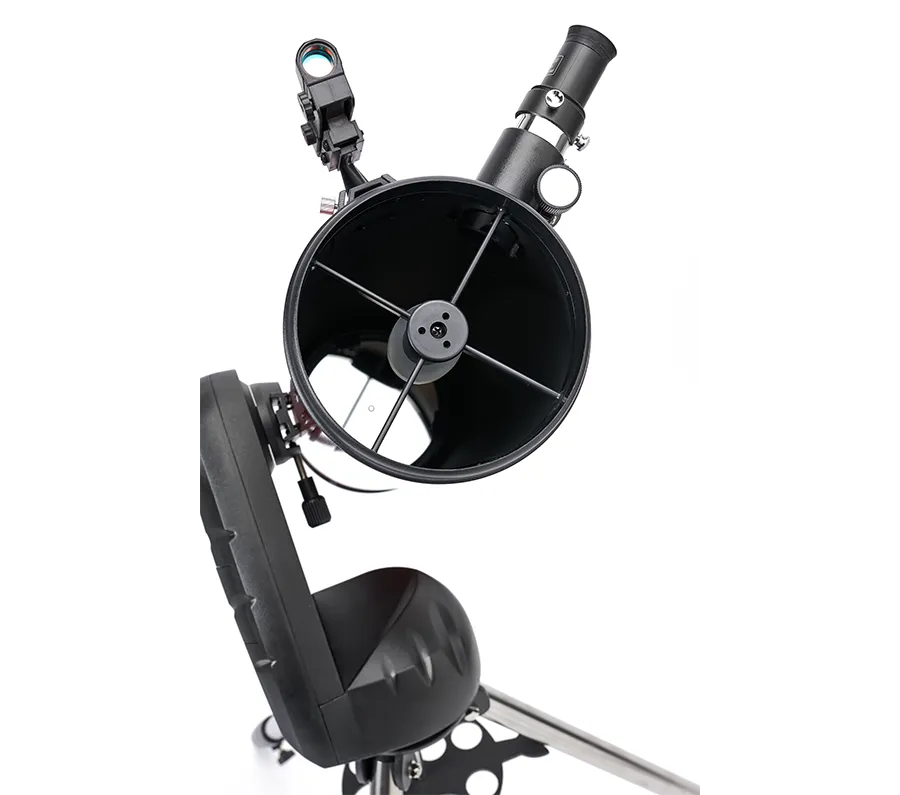
Once the Star Discovery P150i Wi-Fi telescope was switched on we connected it to our smartphone and the SynScan app (iOS and Android versions available) and then we set the telescope to level and pointed it north using the bubble level and compass.
We performed a one-star alignment on Aldebaran (alpha (α) Tauri) and found most of our targets somewhere in the field of view of the 25mm eyepiece.
A more accurate alignment – using either 2 or 3 stars – greatly improved the pointing accuracy and placed most targets close to the centre of the view.
The field of view quality with the 25mm eyepiece showed Rigel (Beta (β) Orionis) as sharp across 70% of the view, so we selected the colourful double star Albireo (Beta (β) Cygni) and were rewarded with a pin-sharp view of the golden and blue pair, nicely separated.
We found that by swapping to the 10mm eyepiece, we had an even better view, with a stronger contrast of colours on display.
Meanwhile, the galaxy pair of M81 and M82 filled the centre view of the 25mm eyepiece and just fitted in the view of the 10mm eyepiece.
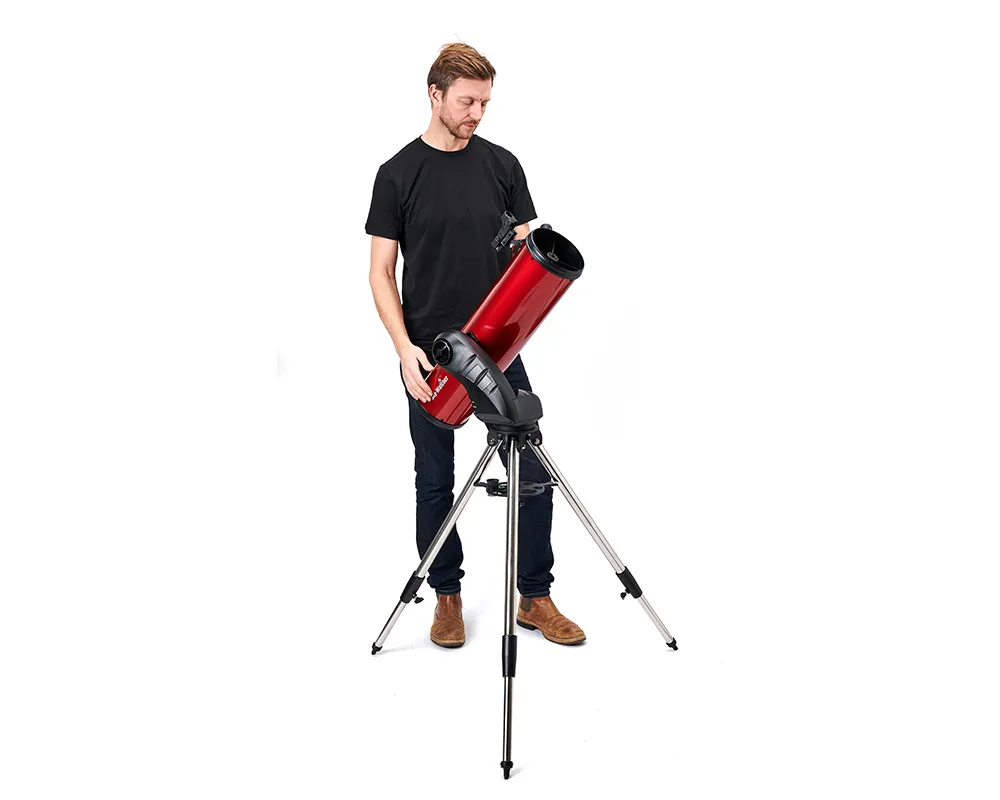
The Pleiades star cluster sparkled in the 25mm eyepiece and the Double Cluster in Perseus particularly impressed us – not just because of the views of its members, but because of the subtle views of the orange stars scattered between them.
The Orion Nebula was stunning, with a higher magnification revealing the Trapezium Cluster at its core.
When it came to Solar System objects, only Mars and the Moon were easily available at the time of the review, but by adding a 2x Barlow lens to the 10mm eyepiece we could make out albedo features and a polar cap on the Red Planet.
We were also pleased to discover that you can spend a long time exploring the detail of the Moon’s features with this system.
Although the Star Discovery 150i is not meant for astrophotography, we added our own smartphone holder and used our iPhone XR and the 25mm eyepiece to image the Moon, the Pleiades and the Orion Nebula, adding to our enjoyment of this telescope.
We can certainly recommend the Star Discovery 150i for those bitten by the astro bug!
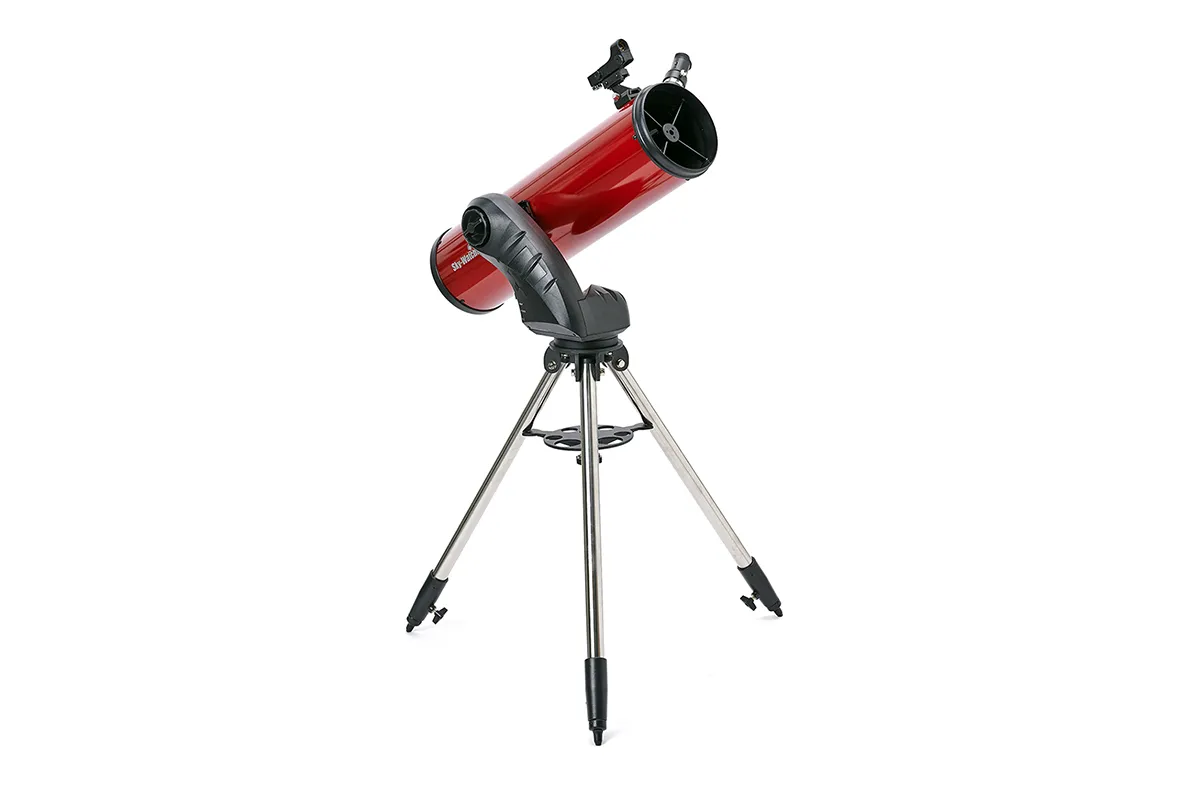
One of the first things you notice about this Star Discovery telescope is that there is no hand-controller – although the mount does have a port for connecting one.
You don’t need a separate controller with this scope because it is operated with an app, connected via the inbuilt Wi-Fi network.
To use it we turned on the power and the mount automatically generated a Wi-Fi network, allowing us to connect our smartphone and later our tablet.
Once connected, you download the SynScan or SynScan Pro app (we used the Pro version) and run it.
There are plenty of observing options in the app, including alignment routines, and Solar System and deep-sky targets.
The SynScan app (right) may not look fancy, but it certainly did the job and allowed us to slew to a wide range of targets with ease.
For those who like to use the popular SkySafari app for Go-To control on iOS devices, the good news is that you now don’t need to have two devices: by choosing ‘SkyWatcher SynScanLink’ in the telescope settings menu, you’ll be able to connect to SkySafari easily and control the mount through that app.
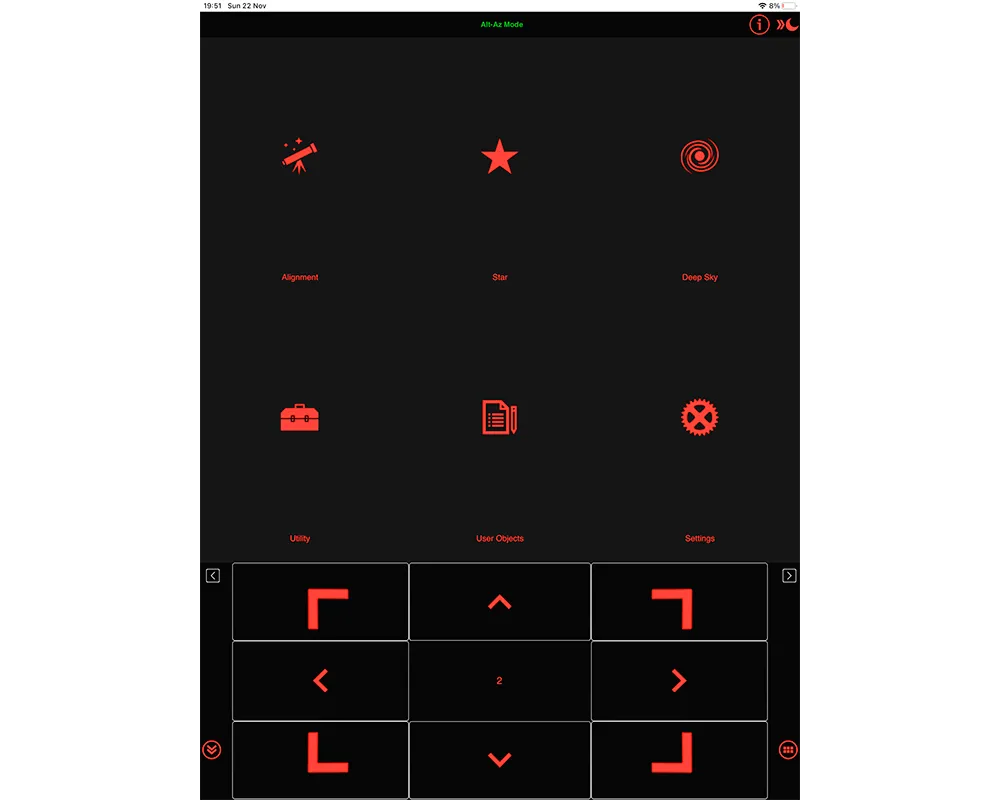
Sky-Watcher Star Discovery P150i outstanding features
Single-arm Go-To altaz mount
The single-arm mount is solid and well made, fitting neatly into the tripod base and held in place with three knobs. The mount has a Vixen-style saddle for attaching the telescope and a good retaining knob for securing the tube firmly in place.
Optics
The Star Discovery 150i is a Newtonian telescope design, with a 150mm parabolic primary mirror and a secondary mirror attached at the front via a spider vane. The ‘short’ focal length of 750mm gives a focal ratio of f/5 that works well for both planetary and deep-sky viewing.
Tripod
The tripod is sturdy with telescopic aluminium legs that can be easily extended – though they spread quite wide at full extension and may be a trip hazard in the dark. The spreader tray can hold both 2-inch and 1.25-inch eyepieces, although only the latter can be accommodated in the telescope’s focuser.
Ports and battery compartment
The mount incorporates an on/off switch and ports for an external 12V power pack, a camera and an optional SynScan handset, although this shouldn’t be needed with the Wi-Fi control. There’s also a compartment for eight
AA batteries, giving a more portable power option.
Focuser and finder
The red dot finder is useful for the initial alignment phase of operation; the focuser is a standard rack and pinion style that takes 1.25-inch eyepieces. Two of these are provided, of 25mm and 10mm, giving magnifications of 30x and 75x, which are suitable choices for the size of telescope.
Vital stats
- Price £459
- Design Newtonian altaz, Go-To, Wi-Fi-controlled telescope
- Optics 150mm (6-inch) parabolic primary mirror
- Focal length 750mm, f/5
- Mount Wi-Fi, computerised, altaz, single-fork arm
- Ports Power connector, camera, hand-controlller, integrated Wi-Fi adaptor
- Tracking rates Sidereal, Lunar and Solar
- Tripod Adjustable with accessory tray
- Extras Red dot finder, 25mm and 10mm 1.25-inch fit eyepieces, bubble level
- Weight 8kg
- Supplier Optical Vision Ltd
- Tel 01359 244200
- www.opticalvision.co.uk
This review originally appeared in the February 2021 issue of BBC Sky at Night Magazine.
